Flea and Tick Prevention and Treatment for Dogs
Preventative care is a key part of keeping your dog healthy and happy. One of the best ways you can prevent potential health issues is to use monthly flea and tick preventatives.
Why Is Flea and Tick Prevention Important for Dogs?
Fleas and ticks are ectoparasites, meaning they are pests that live on the outside of their host.
For fleas and tick to survive, they must bite their host and then feed on the blood. These bites can directly impact your dog’s health. The saliva from a flea bite can cause severe allergies, dermatitis, anemia, itching, and infection. Tick bites can cause infection, abscesses, paralysis, and even death.
These nasty parasites can also harbor and spread a variety of diseases to dogs, including:
- Lyme disease
- Anaplasmosis
- Bartonellosis
- Rocky Mountain Spotted fever
- Tapeworms
- Babesiosis
Some of these diseases are even zoonotic, which means they can spread to you and your family. That is why it’s critical to keep fleas and ticks off your dog, as well as out of your home.
When Do Dogs Need Flea and Tick Prevention?
Flea and ticks survive and thrive in mild to moderate weather, so it’s crucial to protect your pets during the warmer months. If you live in areas where the temperature stays warm year-round, then you should make sure you pet is on flea and tick prevention all year.
However, even northern states frequently experience a few warm, spring-like days during the winter months. These brief warm periods provide fleas and ticks enough time to get on your pets and in your house. Once inside, fleas can continue to reproduce, living in the floorboards, carpets, and anywhere your pet lives. If your dog isn’t using a tick preventive, ticks may even crawl off your dog and onto the humans in the house.
What Are Flea and Tick Preventatives for Dogs?
There are a variety of products to help keep your dog free of parasites. These products can be in the form of pesticides, repellents, or growth inhibitors. Each of these types of preventatives tackle pests at different lifestages to prevent infestations.
Some products are only effective against one species, typically fleas. These include products such as flea dips, baths, and powders. To ensure your dog has coverage for both fleas and ticks, you may need additional medications.
Combination flea and tick preventatives for dogs contain multiple ingredients to battle different types of pests. These prevention options typically provide coverage for both fleas and ticks, but may also provide additional protection against heartworm, mites, or intestinal parasites.
Before deciding on a flea and tick medication, always check with your veterinarian and make sure it is a good fit for your dog. You will want to check the product label and consult with your veterinarian to make sure:
-
The product is the correct species for your pet (dog vs cat)
-
The product is intended for your pet’s life stage: puppy, adult, or senior
-
The product is within the correct weight range for your pet
-
The product is administered correctly (is it a chewable or a topical treatment)
-
The product protects against the appropriate parasites
-
If the product should be given with food
-
How often you should administer the product
-
How long before the product starts working
-
When you can bathe your pet
-
If the product has any other safety-related concerns
-
You have the correct phone numbers to call in the event of an adverse reaction
Even if you’ve previously used the medication, re-read the package insert, as the warnings and directions may have changed. Follow all instructions exactly and contact your veterinarian or the product’s company if you have any questions.
Choosing a Flea and Tick Combination Medicine for Dogs
There is no shortage of options when it comes to flea and tick prevention options for dogs, so finding the best one can feel overwhelming. Your veterinarian is a great resource for narrowing down your search and finding the best fit.
Here are 7 factors to consider as you determine what type of flea and tick medicine is the best for your dog.
Application Method
Flea and tick preventatives most commonly come in two forms:
-
Oral: Chewable tablet that your dog ingests
-
Topical: Liquid that is spread between the should blades or down the back of your dog
Topical flea and tick preventatives are a great option for pets that are picky eaters or have sensitive stomachs. However, if you have small children or other animals, you need to be careful that they don’t touch or lick the product before it has time to dry.
Spot-on flea and tick options may have a medicinal smell or cause transient itching/irritation or even hair loss. Topical treatments are also not a great option for dogs that like to swim a lot or dogs that need frequent baths. Water can affect the efficacy of the product.
Oral treatments can be an easy and convenient option for dog parents because they can be given like a treat. If you use oral treatments, it’s best to monitor your dog to make sure they have eaten the entire tablet and do not throw it up before it can be absorbed into their system.
If your dog vomits after eating an oral flea and tick preventative, call your veterinarian for instructions on re-dosing, as well as to report a potential reaction to the product. Feeding oral preventatives with a meal may help decrease upset stomach as well as help with product absorption.
Geography
Different geographic locations have different local parasite populations, including fleas and ticks, as well as other parasites such as heartworms and intestinal worms.
The Companion Animal Parasite Council is a helpful resource to identify the parasites in your area so that you can make sure whichever flea and tick product you choose keeps your dog fully protected.
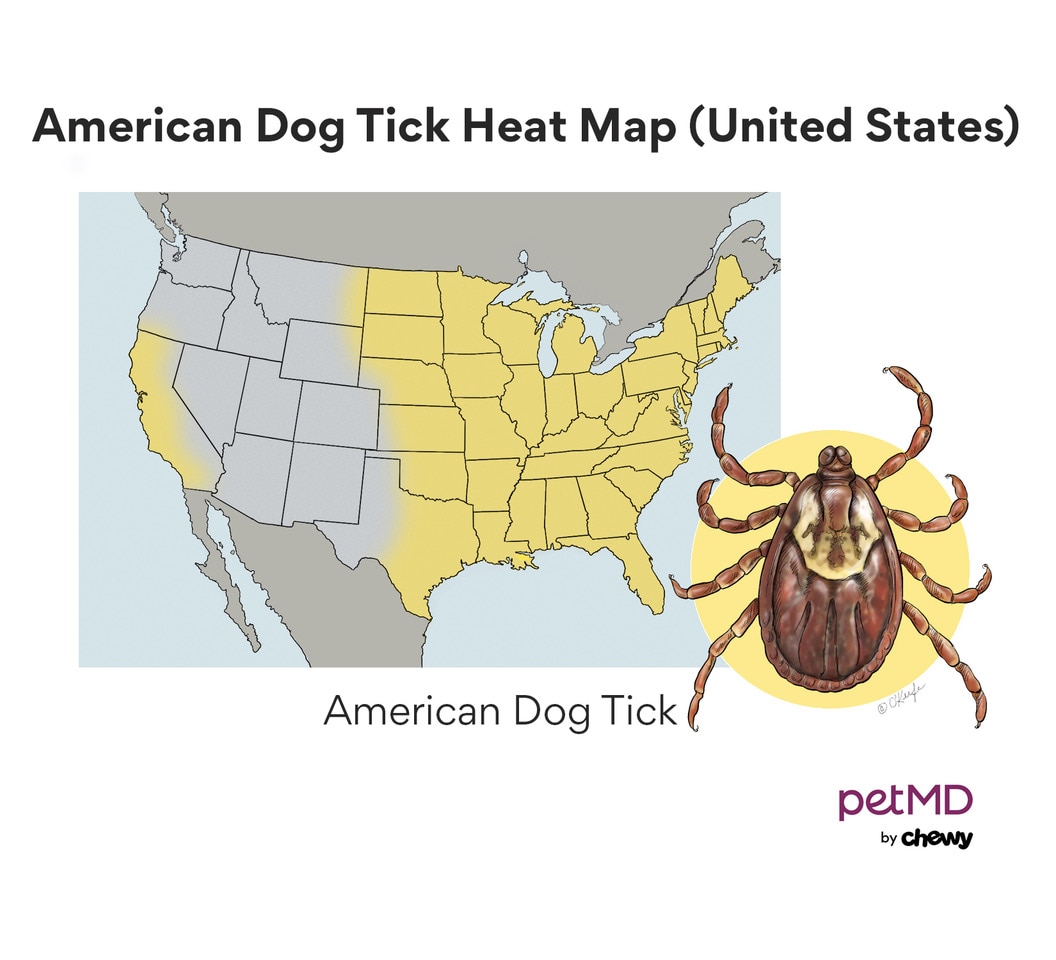
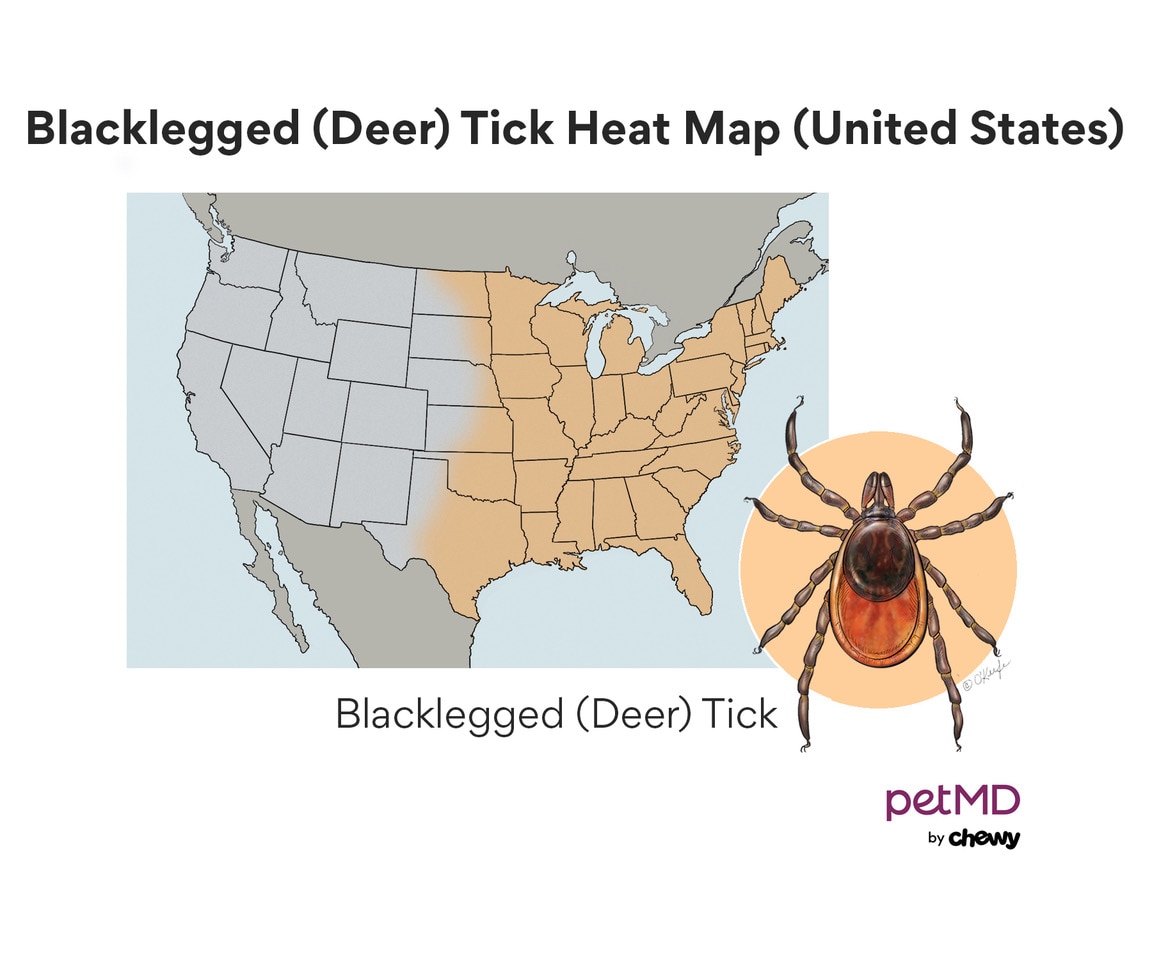
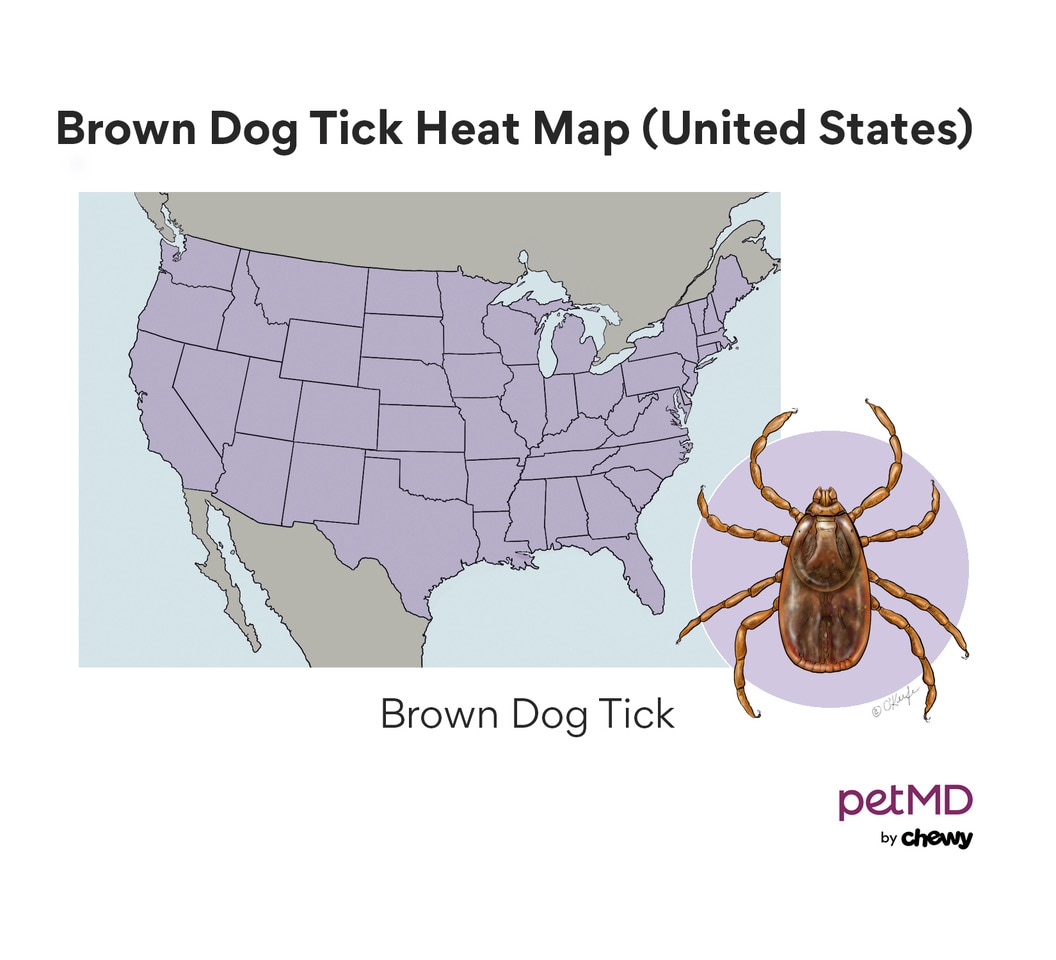
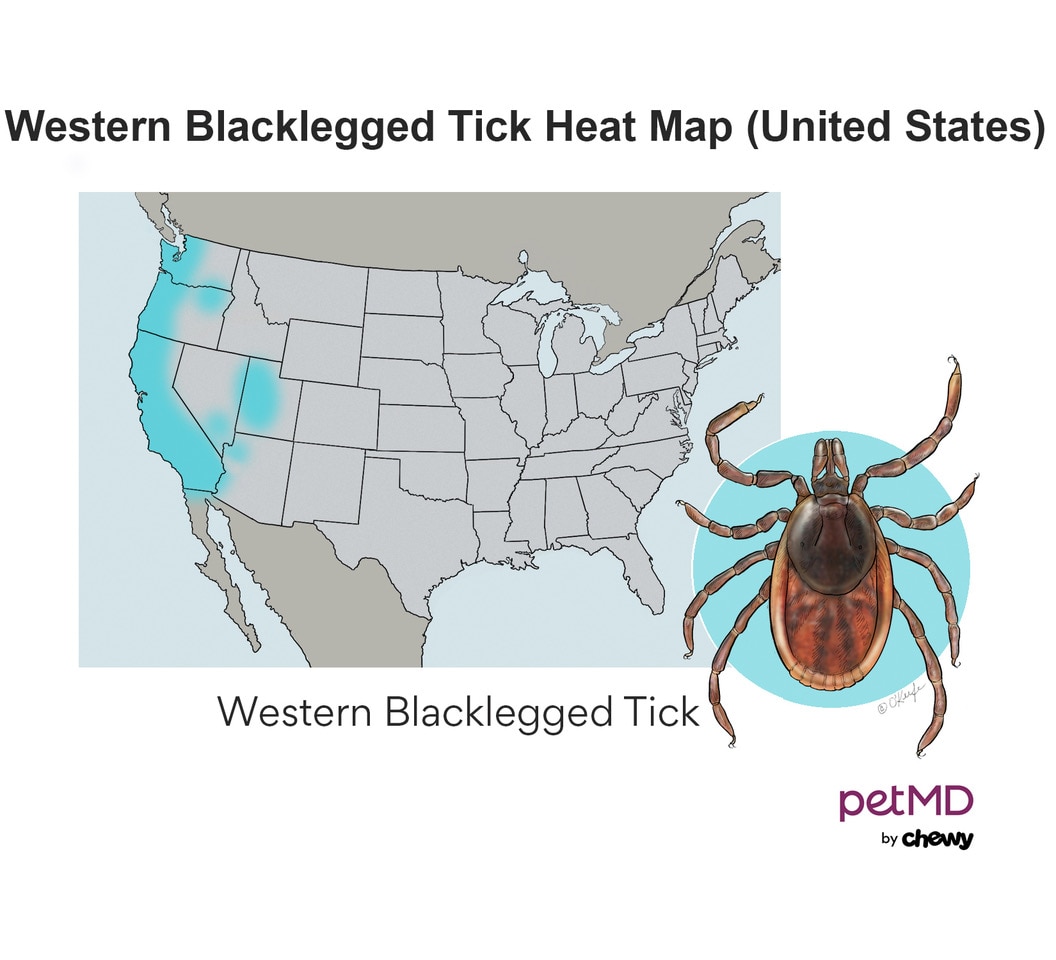
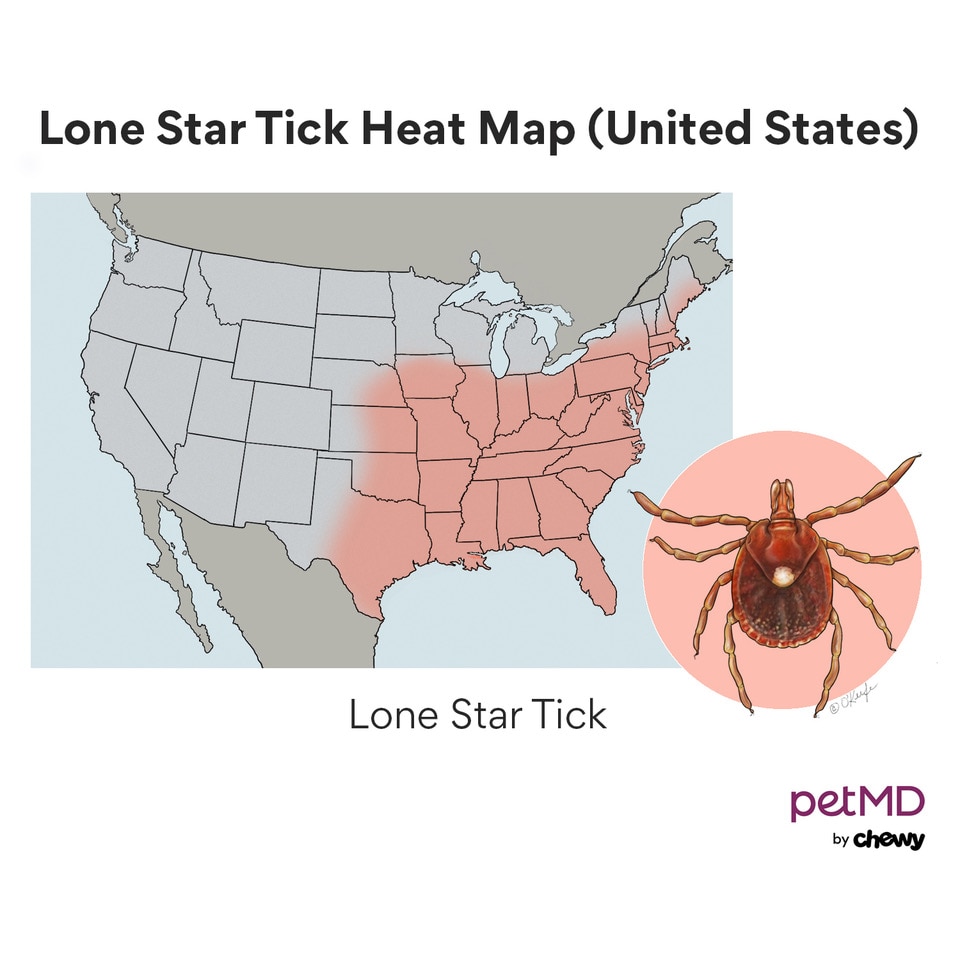
Access to Outdoors
Consider the types of outdoor areas where your dog spends time. Dog parks, hiking trails, parks, and backyards can all be homes to fleas and ticks. If your dog spends a lot of time in wooded areas or spaces where other animals and dogs spend a lot of time, their risk of exposure to parasites goes up.
Even if your dog doesn’t spend a lot of time outside, fleas can easily come in through window screens, on other pets who go outside, or even on a human’s pants and shoes. That’s why veterinarians will always recommend flea and tick prevention regardless of how much time a dog spends outdoors.
MDR-1 Gene
Some breeds (such as Collies, Australian shepherds, and Shetland Sheepdogs, etc.) carry a genetic risk factor for a mutated gene that causes drug sensitivity. These dogs cannot safely process certain drugs, including some ingredients in preventatives.
Many veterinarians recommend testing dogs for the MDR-1 gene, especially affected breeds. The Washington State University Veterinary Clinical Pharmacology Laboratory site has additional information on the mutation as well as which drugs to avoid and ways to test your pet.
Lifestyle
While there is no breed that is particularly at risk of acquiring fleas or ticks, some dogs may be at higher risk due to their personality and breed characteristics. Working, herding, and hunting dogs may spend most of their day in the field, while other dogs are content to stay at home, only venturing outside occasionally.
Lifestage
If your dog is still a puppy or is a small dog breed, you will need to consult your veterinarian to find an appropriate product for their weight or age. Most flea and tick preventatives have a minimum age of 6-8 weeks, but always check the package insert for confirmation.
Medical Conditions
Some classes of preventatives, called isoxazolines, should be used in extreme caution in dogs with a history of seizures or neurologic disease, as it could lower the seizure threshold.
No preventative should be used without thorough discussion with your veterinarian if:
-
Your pet has previously had an allergic reaction to the drug
-
Your pet is sick and/or underweight
-
Your pet is pregnant, nursing, or will be used for breeding in the future
Over-the-Counter vs Prescription Flea and Tick Medicine
As you browse your flea and tick prevention options, you will notice that some products require a prescription from your vet while others do not.
Over-the-Counter Flea and Tick Products
Over-the counter (OTC) flea and tick preventatives do not require a relationship with or prescription from a veterinarian. They are typically available for purchase online and in many retail pet stores.
If you decide on an OTC flea and tick preventative, always check in with your veterinarian to make sure it is a safe option for your pet. Your vet can advise you on:
-
Potential adverse drug interaction with one of your dog’s current medications
-
Potential adverse reaction to your dog’s current medical condition
-
Potentially provide a recommendation for a broader spectrum product for your dog
-
Whether you should consider testing for genetic conditions before starting a preventative
-
Any signs or symptoms of an adverse reaction to the medication
Prescription Flea and Tick Products
Prescription flea and tick preventatives do require a prescription from your veterinarian, but they typically cost a little more than OTC options. Most veterinarians recommend prescription products, as they are typically more effective and safer for your dog.
Many veterinarians agree that while prescription preventatives are more expensive than OTC treatments up-front, they prevent parasite infections and diseases more effectively. This keeps our pets happy and healthy, while also costing less than long-term costs of diagnosis and treatment of diseases spread by fleas and ticks.
Comparing Combination Flea and Tick Medicine for Dogs
The chart below outlines and compares common flea and tick preventatives for dogs. Always check with your veterinarian before starting any product, whether it’s OTC or prescription.
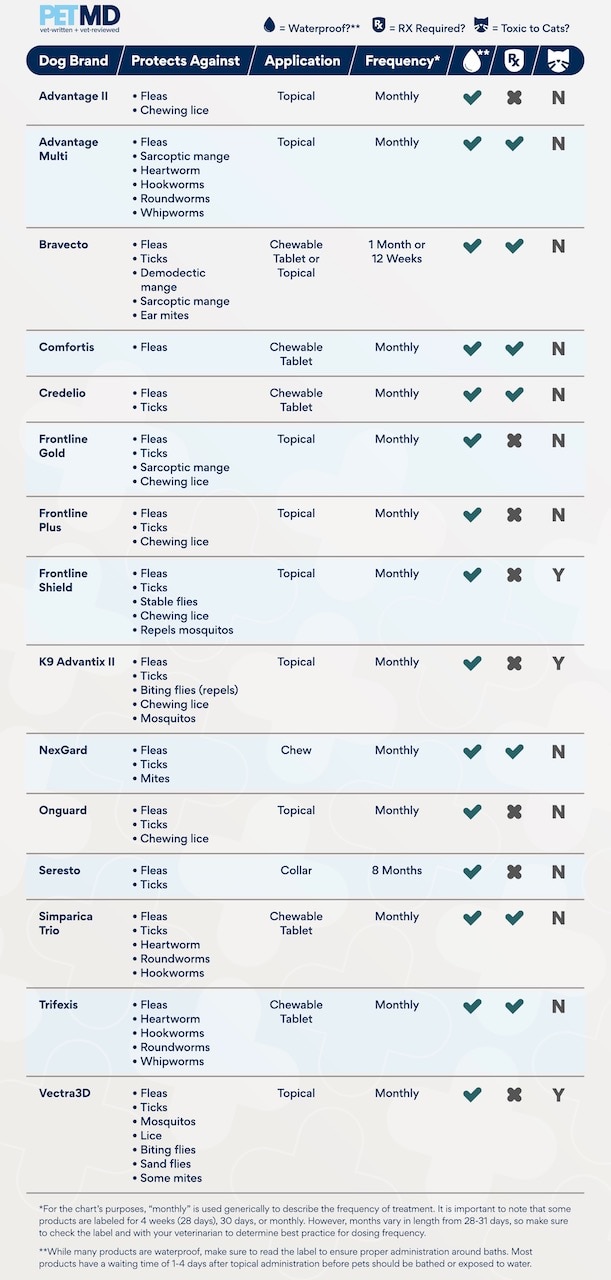
Dog Flea and Tick Prevention Product Summaries
Advantage II is a topical monthly product containing the active ingredients imidacloprid and pyriproxyfen. This combination of drugs is fast-acting and kills all forms of fleas, including eggs, larva, and adults, within hours, as well as chewing lice. However, this product has no tick prevention. This product should only be used in dogs and puppies over 7 weeks and who weigh more than 3 pounds. It is typically applied every month.
Advantage Multi is a topical monthly product containing the active ingredients imidacloprid and moxidectin. This combination of drugs treats fleas, sarcoptic mange, intestinal parasites hookworms, roundworms, and whipworms, as well as preventing heartworm disease. Advantage Multi is fast-acting, killing fleas within hours, but other parasites may take up to 24 hours. This product does not provide tick prevention. This product should only be used in dogs and puppies over 7 weeks and who weigh more than 3 pounds. It is typically applied every month.
Bravecto is a chewable tablet or topical solution containing the active ingredient fluralaner, which is in the isoxazoline drug class. Isoxazolines are absorbed systemically, and therefore must bite the dog to receive the drug. Bravecto is fast-acting, starting to kill fleas within 2 hours and ticks within 12 hours. This drug treats fleas and ticks and comes in three forms:
-
1-month chewable tablet: This product should only be used in dogs and puppies over 8 weeks old and who weigh more than 4.4 pounds. This product is effective against fleas, deer ticks, American dog ticks, brown ticks, and lone star ticks.
-
3-month chewable tablet: This product should only be used in dogs over 6 months of age and over 4.4 pounds. This product is effective against fleas, deer ticks, American dog ticks, and brown ticks for 12 weeks. However, is only effective against the lone star tick for 8 weeks. Ask your veterinarian or review capcvet.org to determine your pet’s risk.
-
3-month topical treatment: This product should only be used in dogs over 6 months of age and over 4.4 pounds. This product is effective against fleas, deer ticks, American dog ticks, and brown ticks for 12 weeks. However, is only effective against the Lone Star tick for 8 weeks.
Bravecto has also proven effective against demodectic, sarcoptic mange, and ear mites. As a drug in the isoxazoline class, all Bravecto products should be used with caution in dogs with a history of seizures, epilepsy, or neurologic disorders.
Comfortis is a chewable tablet containing the active ingredient spinosad. This product treats fleas only. Comfortis is fast-acting agent, killing fleas within 30 minutes of dosing. Dogs and puppies must be 14 weeks or older and weigh over 5 pounds. Comfortis is typically administered every month.
Credelio is a chewable tablet containing the active ingredient lotilaner, which is in the isoxazoline drug class. Isoxazolines are absorbed systemically, and therefore the parasite must bite the dog to receive the drug. Credelio treats fleas and ticks. It is fast-acting, starting to kill fleas within 4 hours of administration. This product should only be used in dogs and puppies over 8 weeks and who weigh more than 4.4 pounds. Credelio is administered every month. As a drug in the isoxazoline class, all Credelio products should be used with caution in dogs with a history of seizures, epilepsy, or neurologic disorders.
Frontline Gold is a topical monthly product containing the active ingredients fipronil, (s)-methoprene, and pyriproxyfen. This combination of drugs kills all fleas (all forms), ticks, and chewing lice. Frontline Gold is fast-acting, killing fleas and ticks within hours. This product should only be used in dogs and puppies over 8 weeks and weighing more than 5 pounds. It is typically applied every month.
Frontline Plus is a topical monthly product containing the active ingredients fipronil and (s)-methoprene. This combination of drugs kills all fleas (all forms), ticks, and chewing lice. Frontline Gold is fast-acting but may take longer than Frontline Gold. This product should only be used in dogs and puppies over 8 weeks and weighing more than 5 pounds. It is typically applied every month.
Frontline Shield is a topical monthly product containing the active ingredients fipronil. permethrin, and pyriproxyfen. This combination of drugs kills all fleas, ticks, chewing lice, and stable flies. It also repels mosquitos, stable flies, and ticks. Frontline Shield is fast-acting, starting to kill fleas in 5 minutes and ticks within 1 hour. This product should only be used in dogs and puppies over 9 weeks and weighing more than 5 pounds. It is typically applied every month. This product is highly toxic to cats, so avoidance or extreme caution should be used in households with cats.
K9 Advantix II is a topical monthly product containing the active ingredients imidacloprid. permethrin, and pyriproxyfen. This combination of drugs repels and kills fleas (all forms), ticks, mosquitos, and chewing lice, while also repelling biting flies. K9 Advantix II is fast-acting, starting to kill parasites within hours. This product should only be used in dogs and puppies over 7 weeks and weighing more than 4 pounds. It is typically applied every month. This product is highly toxic to cats, so avoidance or extreme caution or should be used in households with cats.
Nexgard is a chewable tablet containing the active ingredient afoxolaner, which is in the isoxazoline drug class. Isoxazolines are absorbed systemically, and therefore must bite the animal in order to receive the drug. Nexgard is effective against fleas, deer ticks, American dog ticks, brown ticks, and lone star ticks. It is also effective for extra-label treatment of sarcoptic and demodectic mange. Nexgard starts to kill fleas within 4 hours and ticks up to 48 hours. The monthly product should only be used in dogs and puppies over 8 weeks and who weigh more than 4 pounds. As a drug in the isoxazoline class, all Nexgard products should be used with caution in dogs with a history of seizures, epilepsy, or neurologic disorders.
Onguard Plus is a topical monthly product containing the active ingredients fipronil and (s)-methoprene. This combination of drugs kills all fleas (all forms), ticks, sarcoptic mange, and chewing lice. Onguard is fast-acting. This product should only be used in dogs and puppies over 8 weeks and weighing more than 5 pounds. It is typically applied every month.
Seresto is a collar containing the active ingredients imidacloprid and flumethrin. This combination of drugs kills and repels fleas and ticks for 8 months. Fleas are killed within 24 hours of application and ticks are killed 48 hours after. If a dog is bathed or swims frequently (more than once per month), it may decrease efficacy and need to be replaced as frequently as every 5 months. The product should only be used in dogs and puppies over 7 weeks of age.
Simparica Trio is a chewable tablet containing the active ingredient sarolaner, moxidectin, and pyrantel. Sarolaner is in the isoxazoline drug class. Isoxazolines are absorbed systemically, and therefore must bite the animal in order to receive the drug. Simparica Trio treats fleas, ticks, roundworms, and hookworms, while also preventing heartworm disease. It is also used extra-label to treat demodectic mange, sarcoptic mange, and ear mites. It is also effective for extra-label treatment of sarcoptic and demodectic mange. Simparica Trio is fast-acting, starting to kill fleas and ticks within 4-12 hours. This product should only be used in dogs and puppies over 8 weeks and who weigh more than 2.8 pounds. As a drug in the isoxazoline class, all Simparica products should be used with caution in dogs with a history of seizures, epilepsy, or neurologic disorders.
Trifexis is a chewable tablet containing the active ingredients spinosad and milbemycin oxime. Trifexis is effective against fleas, hookworms, roundworms, and whipworms, while also preventing heartworm disease. It is a fast-acting drug, starting to kill fleas within 30 minutes. This product does provide protection from ticks. Dogs and puppies must be 8 weeks or older and weigh over 5 pounds.
Vectra 3D is a topical monthly product containing the active ingredients dinitefuran, permethrin, and pyriproxyfen. This combination of drugs repels and kills fleas (all forms), ticks, mosquitos, chewing lice, sand and biting flies, and some mites. Vectra is fast-acting, starting to kill parasites within hours. This product should only be used in dogs and puppies over 8 weeks and weighing more than 5 pounds. It is typically applied every month. This product is highly toxic to cats, so avoidance or extreme caution or should be used in households with cats.
References
Help us make PetMD better
Was this article helpful?
